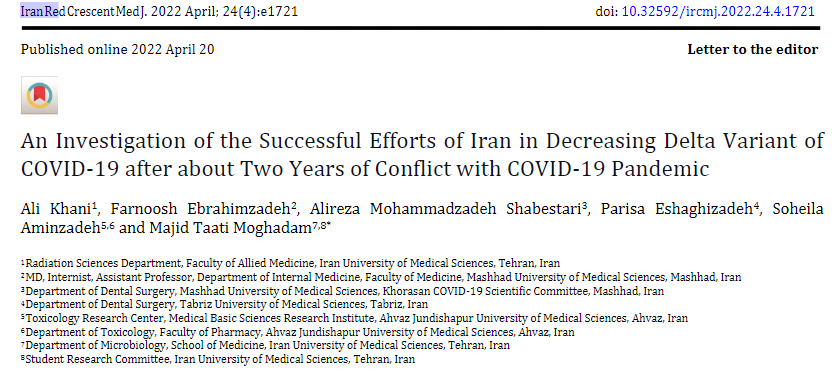
بررسی تلاش های موفقیت آمیز ایران در کاهش نوع دلتا COVID-19 پس از حدود دو سال درگیری با همه گیر COVID-19
در زیر مقاله ارزشمند که در ژورنال https://www.ircmj.com/ که با همکاری چند تن از اساتید برجسته کشوری از جمله آقای دکتر علیرضا محمدزاده شبستری و خانم دکتر اسحاقی زاده و چند تن دیگر از اساتید در خصوص به اشتراک گذاری تخقیقات انجام شده در کشور عزیزمان در این ژورنال معتبر قرار گرفته برای شما عزیزان قرار داده شده است
DownLoad PDF=>1721-Article Text-12524-14099-10-20220515
مقاله علمی جدید کاهش نوع دلتا COVID-19
Ali Khani1, Farnoosh Ebrahimzadeh2, Alireza Mohammadzadeh Shabestari3, Parisa Eshaghizadeh4, Soheila Aminzadeh5,6andMajid Taati Moghadam7,8*1Radiation Sciences Department, Faculty of Allied Medicine, Iran University ofMedical Sciences, Tehran, Iran2MD, Internist, Assistant Professor, Department of Internal Medicine, Faculty of Medicine, Mashhad University of Medical Sciences, Mashhad, Iran3Department of Dental Surgery, Mashhad University of Medical Sciences, Khorasan COVID-19 Scientific Committee, Mashhad, Iran4Department of Dental Surgery, Tabriz University ofMedical Sciences, Tabriz, Iran5Toxicology Research Center, Medical Basic Sciences Research Institute, Ahvaz Jundishapur University of Medical Sciences, Ahvaz, Iran6Department of Toxicology, Faculty of Pharmacy, Ahvaz Jundishapur University of Medical Sciences, Ahvaz, Iran7Department of Microbiology, School of Medicine, Iran University ofMedical Sciences, Tehran, Iran8Student Research Committee, Iran University ofMedical Sciences, Tehran, Iran* Corresponding author:Majid Taati Moghadam, Department of Microbiology, Faculty of Medicine, Iran University of Medical Sciences, Tehran, Iran. Tel:+989119343489; Email: Taatimoghadam.m@tak.iums.ac.ir, Majidtaati1367@gmail.comReceived2021 November 26;Revised2022 January 08;Accepted2022 January 13.Dear Editor,Novel Coronavirus Disease 2019 (COVID-19) was identified and introduced in 2019 as the Spring Festival was being held in China. Afterward, it spread rapidly around the world. On March 11, 2020, the World Health Organization (WHO) announced the outbreak of the COVID-19 pandemic. The first official report of COVID-19 in Iran was announced on February 19, 2020, after two patients were diagnosed with this disease in Qom, Iran (1-6). Less than a year before the outbreak of COVID-19, serious economic and political sanctions were imposed against Iran by the United States (US). The sanctions even penalized non-US companies that traded with Iran, which caused a severe recession in this country. The WHO and other international humanitarian organizations dispatched medical equipment and supplies. However, the sanctions resulted in a seriousshortage of medical supplies necessary for the prevention, diagnosis, and treatment of COVID-19. Current reports from Iran and many other countries are worrying given that the exact size of the disease is still unlikely to be announced. However, even the low estimate is worrying (in 80% of cases) becausemany COVID-19 symptoms are similar to the common cold or flu. Therefore, the diagnosis of these patients and the announcement of accuratereports require sufficient tools (7). Scarcitiesof pharmaceutical, laboratory, and medical equipment, such as protective clothing, face masks, disinfectants, and gloves have led to an increase in the burden of the pandemic, as well as the mortality rate (8). Despite the fact that the US and UN Security Councils have the authority to temporarily lift sanctions under critical circumstances, no action has been taken to ease sanctions on Iran (8). It is a tragedy that tough sanctions have restricted access to necessary supplies, killing many Iranians and spreading COVID-19 tomany countries. It was claimed that Iran played a major role in the transmission of COVID-19 to many neighboring countries in the Middle East and even distant countries; however, all efforts were made to control the outbreak in Iran in spite of all shortages due to sanctions (9, 10). The Ministry of Health and Medical Education prioritized controlling the spread of COVID-19 immediately following the initial reports of disease in Iran. It then organized the National Committee to Combat COVID-19 anddecided to counter this pandemic through the utilization of facilities, knowledge, equipment, as well as the employment of skilled personnel in the country, which resulted in the following actions in Iran:Recommendation of the health and safety protocolssuggested by the WHO, as well as the proper implementation of these recommendations by the national media to educate and inform the public. These recommended protocols include: 1) frequent hand-washing, 2) a three-feet (one meter) social distancing, 3) avoidance of touching the face with contaminated hands, 4) coverage of the mouth and nose when coughing or sneezing, as well as the use of face mask, and 5) attendance at medical centers immediately after the symptoms start The closure of religious sites without prejudice The imposition of restrictions on and the closure of tourist destinations, as well as marketsThe closure of preschools, schools, and universitiesThe reduction of office hours and the closure of unnecessary organizationsThe cancellation of congregational prayer and

